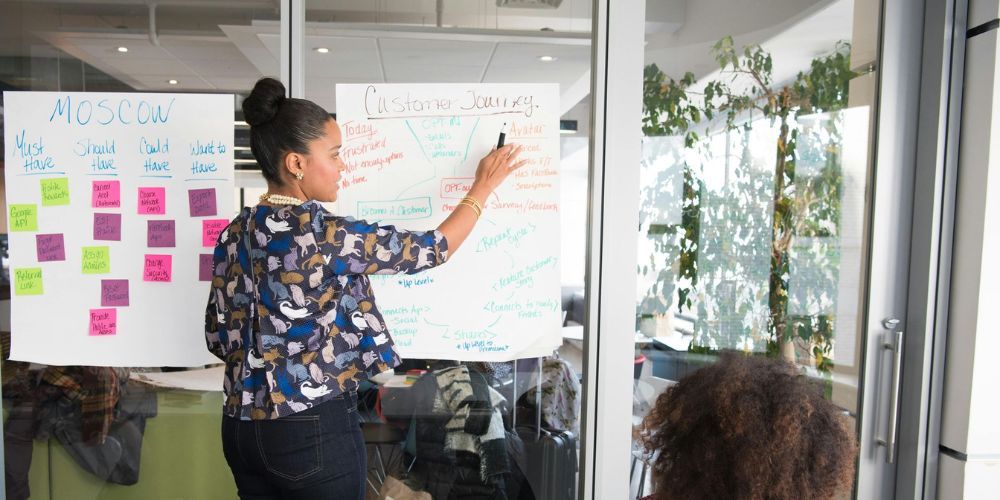Applying Design Thinking to Create a Seamless Customer Journey
In an era where customers demand seamless, personalized digital experiences, companies must rethink how they approach transformation projects. Enter design thinking—a powerful framework that places the customer at the center of every decision. As businesses navigate the complexities of digital transformation, the gap between customer expectations and company capabilities often widens. However, by embracing design thinking principles, organizations can bridge this divide, creating experiences that not only meet but exceed customer expectations.
This guide explores how design thinking can revolutionize your approach to mapping and enhancing the customer journey, ultimately driving loyalty and business success in the digital age.

What is Design Thinking?
At its core, design thinking is a human-centered approach to problem-solving that emphasizes deep empathy with users, creative ideation, and iterative improvement. Unlike traditional problem-solving methods that might begin with technology or business constraints, design thinking starts with understanding human needs and experiences.
This methodology rests on several key principles: empathy with users, creative ideation, rapid prototyping, and continuous iteration. What makes design thinking particularly powerful in digital transformation is its ability to shift focus from a technology-first mindset to a customer-first approach, ensuring that every digital initiative serves a genuine human need.
Why Customer Journey Mapping is Crucial in Digital Transformation
Today's customers interact with businesses across numerous digital touchpoints, from social media to mobile apps to customer service portals. Each interaction forms part of their overall experience with your brand. Without a clear understanding of how customers navigate these touchpoints, businesses risk creating disjointed experiences that frustrate users and erode loyalty.
Consider how a customer moves from discovering your product on social media to making a purchase on your website, then seeking support through your mobile app. Without proper journey mapping, these transitions can feel jarring and disconnected. Customers might encounter inconsistent information, redundant steps, or confusion about where to find what they need. The cost of these friction points is high—research shows that 32% of customers would stop doing business with a brand they loved after just one bad experience.
Applying Design Thinking to Map the Customer Journey
Step 1: Empathize with Your Customers
The foundation of effective journey mapping lies in genuine customer understanding. This goes beyond basic demographic data to uncover the emotional, behavioral, and contextual aspects of customer interactions. Start by:
- Conducting in-depth customer interviews to understand their goals, frustrations, and needs
- Analyzing customer feedback across all channels
- Using behavioral analytics to track how customers actually use your digital platforms
- Creating detailed empathy maps that visualize customer thoughts, feelings, and actions
For example, a retail company recently used customer interviews to uncover significant frustrations with their online checkout process. They discovered that customers weren't abandoning carts due to price concerns, as initially assumed, but because of confusion about shipping options and delivery times. This insight led to a complete redesign of the checkout flow, resulting in a 28% increase in conversion rates.
Step 2: Define the Problem
With rich customer insights in hand, the next step is to clearly articulate the challenges in your current customer journey. This involves:
- Mapping out the current journey to identify pain points and obstacles
- Analyzing where customer expectations differ from actual experiences
- Framing challenges in terms of customer needs rather than business or technical constraints
For instance, instead of defining the problem as "we need to reduce cart abandonment rates," reframe it as "how might we make the checkout experience more transparent and confidence-inspiring for our customers?"
Step 3: Ideate Potential Solutions
This is where creativity meets customer insight. Bring together cross-functional teams to generate innovative solutions that address the defined challenges. Successful ideation sessions:
- Include representatives from marketing, development, design, and customer service
- Use structured brainstorming techniques to generate diverse ideas
- Consider how emerging technologies could enhance the customer experience
- Focus on quantity of ideas before evaluating quality
A SaaS company employed this approach when redesigning their user onboarding process. By bringing together team members from different departments, they generated innovative solutions like personalized onboarding paths based on user roles and interactive tutorials triggered by user behavior.
Step 4: Prototype and Test
Turn promising ideas into tangible solutions through rapid prototyping and testing. This might involve:
- Creating low-fidelity wireframes or clickable prototypes
- Testing prototypes with real customers
- Gathering feedback through usability testing sessions
- Iterating based on user feedback
An airline recently used this approach when redesigning their mobile app's seat selection feature. They created several prototype versions and tested them with frequent flyers, discovering that users preferred a 3D view of the cabin with real-time seat availability updates. This insight shaped the final design, which increased customer satisfaction scores by 45%.
Step 5: Implement and Monitor
Implementation should be viewed as an ongoing process rather than a final destination. Successful implementation involves:
- Rolling out changes in phases to manage risk and gather feedback
- Monitoring key metrics like Net Promoter Score (NPS), engagement rates, and conversion rates
- Maintaining open feedback channels with customers
- Continuously iterating based on performance data and customer feedback

Benefits of Using Design Thinking in Digital Transformation
Organizations that embrace design thinking in their digital transformation efforts experience numerous significant advantages that extend far beyond basic customer satisfaction metrics:
Enhanced Customer Satisfaction and Loyalty
When companies truly understand and address customer needs through design thinking, they create experiences that don't just satisfy—they delight. This deep understanding leads to:
- Increased customer retention rates, with design-led companies reporting up to 32% higher customer retention
- Stronger emotional connections with the brand, driving repeat purchases and referrals
- Higher Net Promoter Scores (NPS) and customer satisfaction metrics
- More authentic customer relationships built on genuine understanding rather than assumptions
Accelerated Innovation and Adaptability
Design thinking creates a framework for rapid innovation that helps organizations:
- Identify emerging customer needs before competitors
- Develop solutions that address root causes rather than symptoms
- Adapt quickly to changing market conditions and customer preferences
- Create a culture of continuous improvement and innovation
- Transform customer feedback into actionable product and service enhancements
Reduced Risk and Resource Optimization
The iterative nature of design thinking helps organizations minimize waste and manage risk effectively:
- Early prototyping and testing reduce the cost of failures by catching issues before full implementation
- Customer validation at every stage ensures resources are invested in solutions that will actually be used
- Rapid iteration cycles allow for quick pivots when needed, minimizing sunk costs
- Data-driven decision making reduces reliance on gut feelings or assumptions
- Clear success metrics help track ROI and justify further investments
Improved Cross-Functional Collaboration
Design thinking breaks down traditional organizational silos by:
- Creating shared customer-centered goals that unite different departments
- Establishing common languages and frameworks for problem-solving
- Fostering creativity and innovation across all levels of the organization
- Encouraging diverse perspectives and inclusive solution development
- Building stronger connections between technical and non-technical teams
Higher ROI and Business Impact
When digital initiatives are aligned with genuine customer needs through design thinking, organizations see concrete business results:
- Reduced development cycles and faster time-to-market
- Lower customer acquisition costs due to better product-market fit
- Increased customer lifetime value through improved experiences
- Higher conversion rates and reduced abandonment
- More efficient resource allocation based on validated customer needs
Enhanced Employee Engagement
Design thinking doesn't just benefit customers—it also positively impacts employees by:
- Providing clear purpose and connection to customer outcomes
- Empowering teams to contribute creative solutions
- Creating more engaging and meaningful work experiences
- Reducing frustration from working on unused features or products
- Building stronger connections between daily work and customer impact
Competitive Advantage
Organizations that excel at design thinking gain significant market advantages:
- Better anticipation of customer needs and market trends
- More innovative solutions that differentiate from competitors
- Stronger brand reputation for customer-centricity
- Increased agility in responding to market changes
- Higher barriers to entry for competitors due to superior customer experience
Sustainable Growth
Design thinking creates a foundation for sustainable business growth by:
- Building scalable solutions based on deep customer understanding
- Creating systematic approaches to innovation and improvement
- Developing stronger customer relationships that weather market changes
- Establishing feedback loops that drive continuous improvement
- Aligning organizational capabilities with market opportunities
The compounding effect of these benefits creates a virtuous cycle: as organizations become more proficient in design thinking, they become better at identifying and solving customer problems, which leads to improved business results and stronger customer relationships. This, in turn, provides more resources and opportunities for further innovation and improvement.

Practical Tips for Integrating Design Thinking into Your Strategy
Implementing design thinking doesn't require a complete organizational overhaul. Here's a comprehensive guide to getting started and scaling your design thinking practice effectively:
Start Small but Think Big
Begin with manageable initiatives while maintaining a vision for broader implementation:
- Choose a single, high-impact customer touchpoint for your first project
- Select problems that are meaningful but contained enough to show quick wins
- Document your process and learnings to create templates for future projects
- Set clear success metrics that align with broader business goals
- Create a roadmap for gradually expanding design thinking across the organization
Build and Empower Cross-Functional Teams
Create diverse teams that bring multiple perspectives to customer challenges:
- Include representatives from design, technology, business, and customer service
- Assign clear roles and responsibilities while maintaining flexibility
- Ensure team members have dedicated time for design thinking activities
- Provide training and resources to build design thinking capabilities
- Establish regular communication channels and feedback loops
Develop a Design Thinking Toolkit
Invest in the right mix of tools and resources:
- Collaboration platforms (Miro, MURAL) for virtual workshops and ideation
- Prototyping tools (Figma, Adobe XD) for rapid visualization
- Research tools (UserTesting, Hotjar) for customer insight gathering
- Project management software (Trello, Asana) for tracking progress
- Analytics platforms for measuring impact and success
Create Structured Processes
Establish clear frameworks while maintaining flexibility:
- Develop templates for common design thinking activities
- Create guidelines for conducting customer research
- Set up regular review and feedback sessions
- Implement stage-gate processes for moving projects forward
- Build quality control checkpoints throughout the process
Foster a Learning Culture
Build an environment that encourages experimentation and growth:
- Celebrate learning from failures as much as successes
- Share case studies and lessons learned across teams
- Create spaces for informal knowledge sharing and mentoring
- Establish communities of practice around design thinking
- Provide ongoing training and skill development opportunities
Measure and Communicate Impact
Track and share the results of your design thinking initiatives:
- Define clear success metrics before starting projects
- Use both quantitative and qualitative measurements
- Create regular reporting mechanisms for sharing outcomes
- Document and communicate success stories
- Use data to make the case for expanding design thinking practices
Secure Leadership Buy-In
Ensure sustained support for design thinking initiatives:
- Align design thinking goals with strategic business objectives
- Regularly update leadership on progress and outcomes
- Demonstrate ROI through concrete metrics and success stories
- Involve leaders in key design thinking activities when appropriate
- Create executive champions for design thinking across departments
Scale Systematically
Expand your design thinking practice thoughtfully:
- Create a center of excellence to support scaling efforts
- Develop internal training programs and certification paths
- Build a network of design thinking champions across departments
- Standardize key processes while allowing for customization
- Establish governance frameworks for larger initiatives
Integrate with Existing Systems
Connect design thinking with current business processes:
- Align with agile development practices
- Integrate with project management methodologies
- Connect to existing customer feedback systems
- Incorporate into strategic planning processes
- Link to performance management systems
Build External Partnerships
Leverage outside expertise and perspectives:
- Partner with design thinking consultancies for specific projects
- Join design thinking communities and networks
- Attend industry events and conferences
- Share experiences with peer organizations
- Engage with academic institutions for research and training
Plan for Sustainability
Ensure long-term success of your design thinking practice:
- Create sustainable funding models for design thinking initiatives
- Develop succession planning for key roles
- Build institutional knowledge management systems
- Establish ongoing training and development programs
- Regular review and refresh of processes and tools
Remember that successful integration of design thinking is an iterative process itself. Start with these foundations, but be prepared to adapt and evolve your approach based on what works best in your organizational context. Regular assessment and adjustment of your design thinking practice ensures it remains effective and continues to deliver value to both your organization and your customers.
Case Study: How FinTech Corp Transformed Their Mobile Banking Experience
A FinTech company faced declining mobile app usage and increasing customer complaints about their digital banking services. Using design thinking, they:
- Conducted extensive customer research, revealing that users found their app overwhelming and difficult to navigate
- Defined the core problem as helping customers complete common banking tasks in three taps or less
- Ideated solutions through workshops involving designers, developers, and customer service representatives
- Prototyped and tested a simplified app interface with personalized shortcuts based on user behavior
- Implemented changes gradually, monitoring user feedback and metrics
The results were significant:
- 40% increase in mobile banking engagement
- 65% reduction in customer support calls
- 92% positive feedback on the new interface
Design thinking offers a powerful framework for creating digital experiences that truly resonate with customers. By placing customer needs at the center of digital transformation efforts, organizations can create seamless journeys that drive satisfaction, loyalty, and business growth.
As you evaluate your own customer journey, consider how design thinking principles might help you better understand and serve your customers. Start small, remain curious about your customers' needs, and remember that creating exceptional experiences is an ongoing journey rather than a destination.
Ready to begin? Start by mapping one key customer journey and identifying opportunities where design thinking could drive meaningful improvements in the experience you deliver.
How does design thinking enhance the customer journey?
Design thinking focuses on empathy, ideation, and iterative problem-solving to deeply understand customer pain points and expectations. By mapping the customer journey through workshops and interviews, organizations can identify friction points and opportunities to improve user experiences. This approach ensures that every interaction aligns with customer needs, fostering loyalty and engagement.
What are the key steps in applying design thinking to customer journey mapping?
The process involves:
- Empathizing: Understanding your customers through research, surveys, and interviews to uncover their needs and challenges.
- Defining: Clearly identifying the core problems or obstacles in the current journey.
- Ideating: Brainstorming creative solutions with cross-functional teams to address these issues.
- Prototyping: Developing low-fidelity models of new experiences to test ideas quickly and cost-effectively.
- Testing: Gathering feedback from real users to refine and iterate solutions before full-scale implementation.
What are some examples of design thinking driving customer journey improvements?
Organizations have used design thinking to streamline onboarding processes, reduce friction in e-commerce checkouts, and create personalized customer support systems. For example, mapping the end-to-end journey of a healthcare patient might reveal delays in appointment scheduling, leading to the implementation of AI chatbots for real-time assistance. Similarly, retail brands have used design thinking to redesign omnichannel experiences, ensuring seamless transitions between online and in-store shopping.










